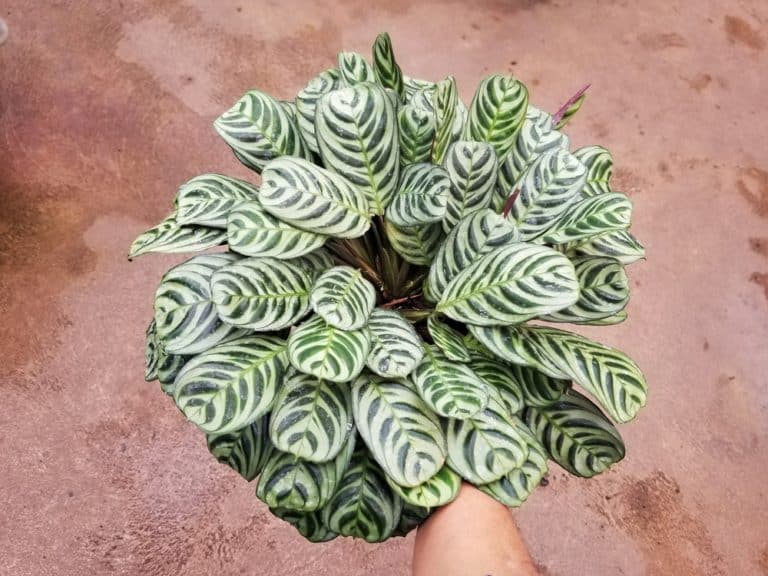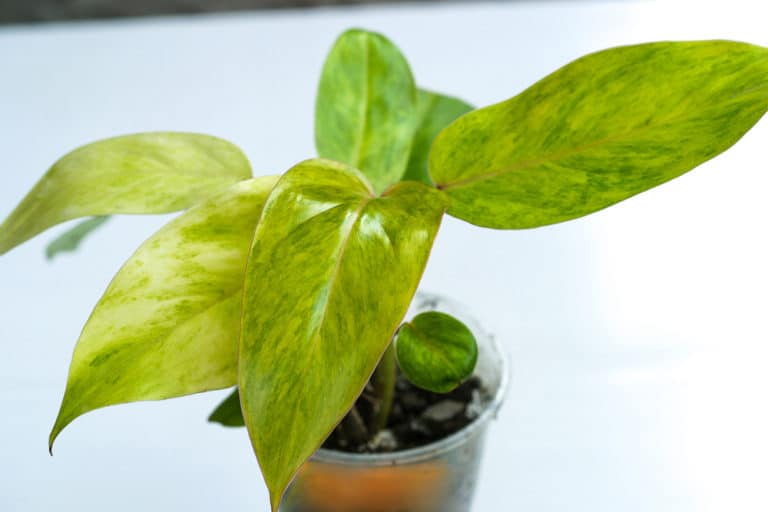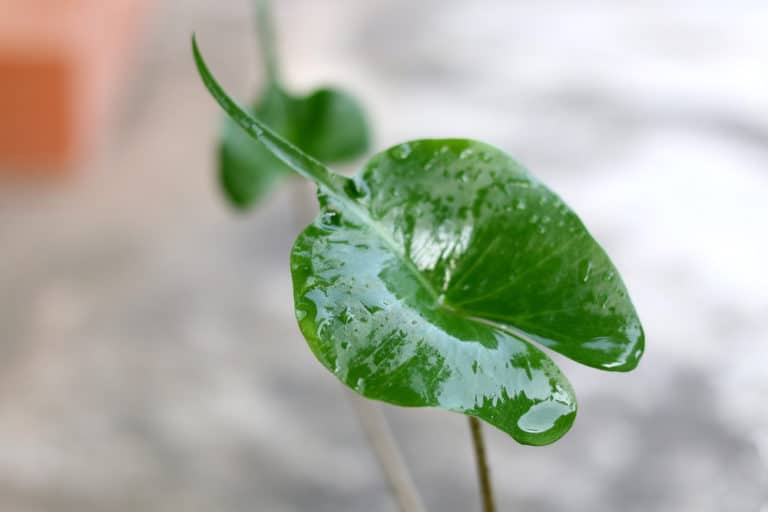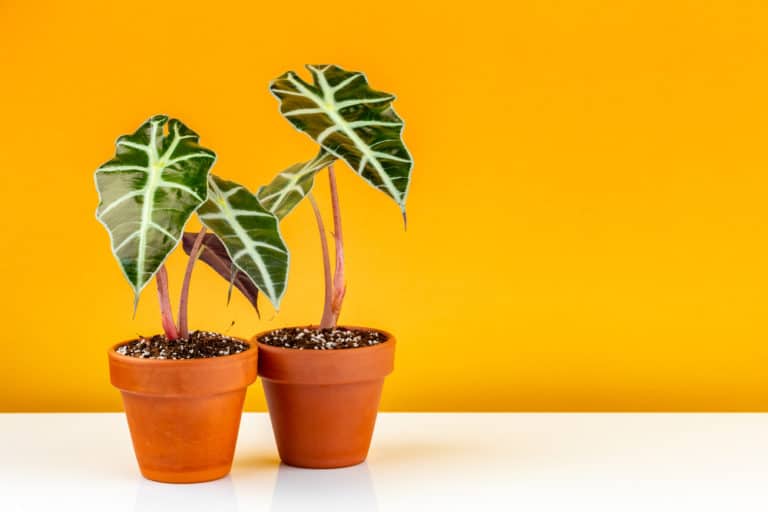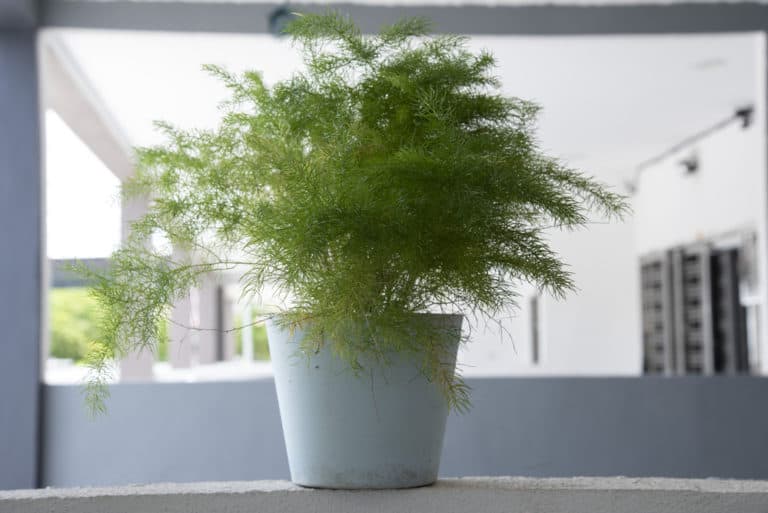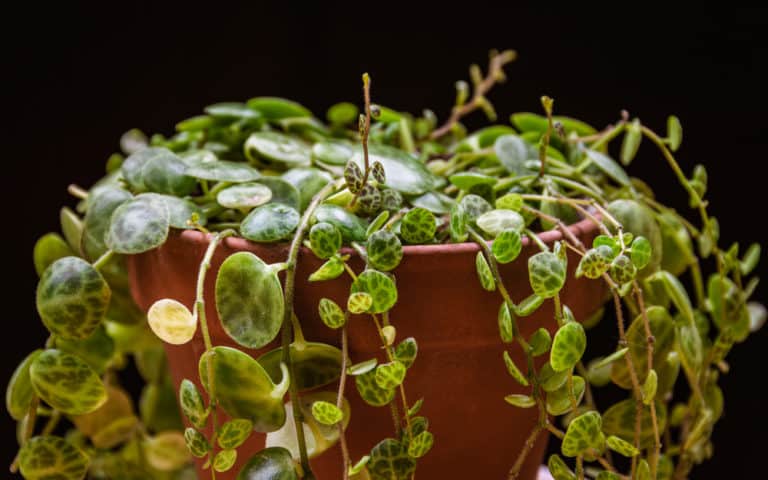Epipremnum Aureum ‘Pearls and Jade Pothos’ Care (2024)
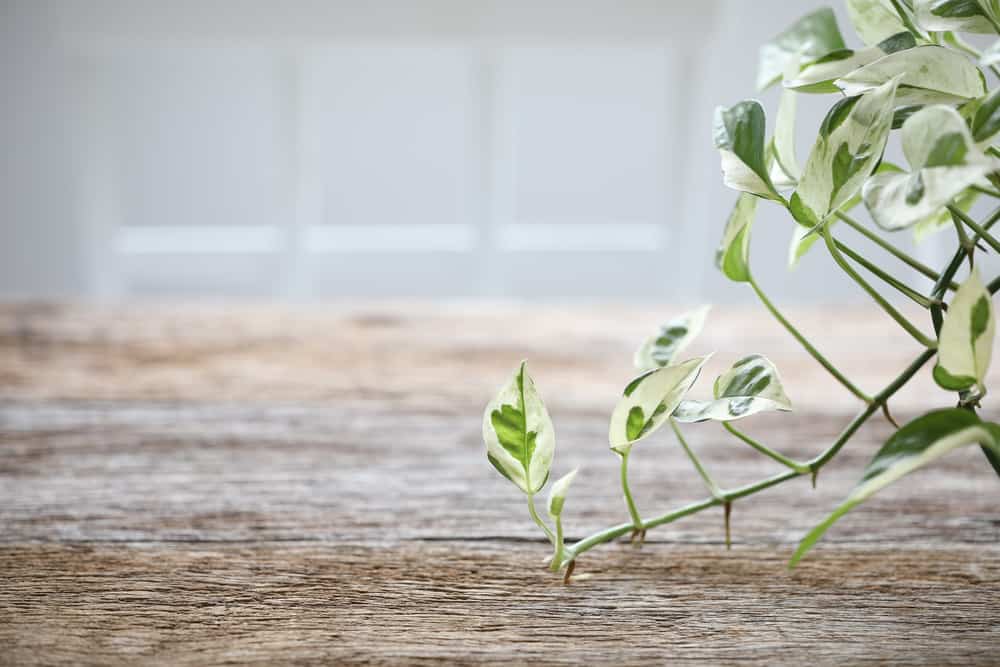
The Pearls and Jade pothos is a recent new cultivar of the pothos plant, prized for its attractively variegated foliage.
Epipremnum aureum ‘Pearls and Jade’ is easy to grow and will soon add a tropical feel to your home as its vines spread.
Its evergreen foliage provides year-round color indoors.
| Scientific Name | Epipremnum aureum ‘Pearls and Jade’ |
| Common Name | Pearls and Jade Pothos |
| Light | Bright indirect sunlight |
| Watering | Weekly, water if the top half of the soil is dry |
| Temperature | 60 to 85ºF (15 to 29ºC) |
| Hardiness Zone | 10 to 12 |
| Humidity | 50 to 70% |
| Soil Type | Quick-draining, loamy |
| Soil pH | 6.1 to 6.5 (mildly acidic) |
| Fertilizing | A balanced feed once a month in spring and summer |
| Repotting | Every 2 years |
| Pruning | When required |
| Propagation | Root in water or soil |
| Toxicity | Toxic to humans and pets |
| Mature Size | 8 to 10-foot vines as a houseplant |
| Bloom Time | Does not flower |
What’s Unique About Pearls and Jade Pothos?
The Pearls and Jade pothos plant has never grown in the wild. It’s a mutation of the Marble Queen pothos that is native to French Polynesia in the South Pacific.
Pearls and Jade pothos plants were developed at the University of Florida and patented in 2008, so they’re a newcomer on the houseplant scene.
Their heart-shaped leaves generously splashed in shades of white and green have made them a favorite of growers ever since.
Even better, growing Pearls and Jade pothos is very easy, even for first-timers.
And like all pothos plants, Pearls and Jade has been proven to be very effective at removing chemicals and even odors from indoors environments.
Pearls and Jade Pothos Care
This pothos family originates in the steamy South Pacific rainforests.
You need to be aware of this habitat for good Pearls and Jade pothos plant care, although you don’t need to live in a tropical rainforest to keep this houseplant happy.
Your Pearls and Jade care should focus on keeping your tropical plant in a warm and humid environment in filtered light.
Light
In the tropical rainforests where the wild parent of Pearls and Jade pothos evolved, the pothos vines climb the trees whose canopy shades them from the blinding sun overhead.
In your home, Pearls and Jade pothos light requirements are for bright but indirect light, or between 10,000 to 20,000 lux.
Pearls and Jade light needs are best met by setting your plant directly in a north or east-facing window, or several feet away from a south or west exposure.
Full sun can scorch the leaves, and too much shade will cause your Pearls and Jade pothos leaves to revert to solid green.
Watering
In the rainforests of French Polynesia, it rains every other day in summer, and even in the dry season, the average is at least twice a week.
However, pothos plants grow in very well-draining soil and are not used to overly wet conditions.
In your home, Pearls and Jade pothos watering should be done when the top half of the soil is dry.
To water Pearls and Jade, soak the whole pot in a pail of room temperature water until it is saturated, and then let all the excess drain completely.
Your Pearls and Jade pothos watering needs will slow down in winter when it’s not actively growing.
Temperature
It is never other than hot in the Polynesian rainforests. In its coolest season, the average temperature is still just below 82ºF(30ºC).
However, in your home the acceptable Pearls and Jade pothos temperature range is 60 to 85ºF (15 to 29ºC).
Basically, any temperature that is good for you is a good temperature for Pearls and Jade. Just be careful to keep it out of drafts and away from cold windows.
Your Pearls and Jade pothos will appreciate a couple of months outside in hot weather, but be aware that it has limited temperature tolerance below 50°F (10°C).
Bring it back in long before the first frost, as it has no cold hardiness whatsoever.
Humidity
The South Pacific rainforests are steamy places. Even in the “dry” season, the relative humidity barely goes below 80%.
While you don’t have to keep your home quite that damp, the ideal humidity for Pearls and Jade is between 50 and 70%.
You may be able to get away with 40%, but if you start to notice brown tips on the leaves, you will need to increase the humidity level.
Misting the leaves daily can get tedious, and is really only a temporary fix.
The best way to satisfy your Pearls and Jade pothos humidity requirements is by creating a moist microclimate with a small humidifier.
Soil
Pearls and Jade pothos soil has a couple of equally important requirements: it must retain a moderate amount of moisture, but also drain well.
If your Pearls and Jade pothos sits in consistently wet soil, it will die.
The best pH level for Pearls and Jade is 6.1 to 6.5, or mildly acidic.
A good commercial soil for Pearls and Jade is an aroid mix, which you may be able to find at a local nursery or online.
However, you can also make your own soil mix with readily available ingredients.
You can combine 1 part potting soil with 2 parts peat moss for a good, loose mix with plenty of organic matter.
Fertilizer
You do not need to use a lot of Pearls and Jade pothos fertilizer, but a little boost can improve the overall growth of this plant.
The easiest way to provide fertilizer for Pearls and Jade is by adding a handful of well-rotted compost to your potting soil. You will not need to use any other nutrients if you do this.
Otherwise, use a liquid fertilizer with a balanced 10-10-10 fertilizer ratio. Dilute it to half its recommended strength and apply to the soil right after you’ve watered.
Use this once a month in the growing season, and stop in the fall and winter.
Potting & Repotting
Pearls and Jade pothos repotting should be done every couple of years, but rather than following a strict schedule, base it on your observations.
It’s time for repotting Pearls and Jade when the roots start snaking out of the drainage holes and the foliage completely hides the pot.
Go up one pot size, as too much extra soil will stay wet too long and can cause root rot.
An unglazed clay pot is perfect for helping to keep the soil from staying too moist, and it must have good drainage holes.
Always use fresh potting soil to prevent a build-up of disease.
Pruning
Pearls and Jade pothos pruning can be done at any time of the year to keep your vining plant looking its best.
If you prefer a bushy, upright shape to one with lots of trailing vines, pinch back the stems when they get too long.
Nip them right above a node to encourage side shoots to develop for a fuller look.
You can also cut stem tips to keep vines to a desired length.
Of course, you should always trim off dead or damaged leaves as soon as they occur.
When cutting Pearls and Jade, always use sharp, sterilized scissors to prevent the spread of disease.
Propagation
The first thing to be aware of with Pearls and Jade pothos propagation is that it is patent protected until 2028.
However, you can still propagate Pearls and Jade for yourself or to share with friends.
All you have to do is take a stem cutting with at least 2 nodes and a few leaves.
Strip off all but the top leaves and clip the stem just below the lowest node.
Put the stems in a jar of water or moist soil in a warm and humid spot out of the bright sun, and within a few weeks you should see new roots forming.
Also, make sure to check out our in-depth global green Pothos plant care guide.
Common Problems of Pearls and Jade Pothos
While these plants are pretty tough to kill, you may still encounter a few Pearls and Jade pothos problems.
However, most problems with Pearls and Jade can be prevented with good growing conditions.
Still, if you see that the beautiful leaves are looking under the weather, it’s best to deal with the issues promptly.
Pests
Pearls and Jade pothos pests are less likely to attack a healthy plant growing under ideal conditions.
You can also prevent most bugs from infesting your Pearls and Jade if you spray the leaves once a month with an insecticidal soap or neem oil solution.
Spider mites may make their presence known with little yellow bumps on the leaves or fine webs.
Aphids are small green insects found underneath the leaves or on the stems.
Both can be rinsed off with a shower or sink nozzle.
Scale look like flat brown bumps and can be scraped off.
Mealybugs are fuzzy white bugs that gather on the underside of the leaves. Wipe them away with a cotton ball dipped in rubbing alcohol.
Diseases
You are much more likely to encounter Pearls and Jade pothos diseases if you don’t let the soil dry out enough between waterings, or let the foliage get wet.
Pearls and Jade plants are prone to bacterial and fungal diseases under those conditions.
Bacterial leaf spot starts with brown spots surrounded by yellow haloes. The spots then turn into holes, killing the leaf.
Isolate the plant, and cut off all affected foliage and discard them in the garbage. Improve air circulation around your Pearls and Jade pothos and keep the leaves dry.
Root rot is always a risk. If the leaves are yellowing and the stems are soft, check the roots.
If they’re turning black, cut away all affected parts and repot it in fresh soil in a disinfected pot.
Growing Problems
Growing problems are sometimes just a case of your Pearls and Jade pothos not getting the growing conditions it needs to thrive.
The good news is that your sick plant can usually be saved just by improving those conditions.
If the variegated foliage is reverting to solid green, you’re probably not giving your Pearls and Jade pothos enough light.
Brown leaf tips can indicate too much fertilizer or not enough humidity.
Yellowing leaves may mean you’re overwatering your Pearls and Jade pothos, or it needs fertilizer.
Dropping leaves can be a sign that your Pearls and Jade pothos is root bound, and needs to be repotted.
Toxicity of Pearls and Jade Pothos
Pearls and Jade plants are toxic to both humans and pets.
Its toxicity is due to the calcium oxalate crystals that are found in all parts of the plant. The tiny crystals or raphides will pierce delicate tissues.
It’s important to keep your Pearls and Jade pothos out of reach of both children and animals.
For Humans
The Pearls and Jade pothos is toxic to humans, although a life-threatening event is rare.
For adults, the main concern is exposure to the sap, which can cause a painful rash. If you get some on your skin, rinse it thoroughly.
Children are more at risk, simply because they are curious and may try eating a leaf. They won’t do more than a little nibble, because they will immediately experience pain.
Get them to rinse and spit, and clean off any plant material that remains. Then give them something soothing and cool like ice cream to numb the pain.
However, if their tongue or airways are swollen, take them to the emergency room.
For Pets
The Pearls and Jade pothos is toxic to all household pets, including cats, dogs, and rabbits.
If your pet has eaten some foliage, and has vomiting, diarrhea, or excessive drooling, do not attempt to treat it yourself. Take it to the veterinarian immediately, as the toxins can cause serious damage if not treated promptly.
It’s best to prevent such incidents before they occur by keeping your Pearls and Jade pothos out of reach of pets or children.
It’s a perfect plant for a hanging basket or high shelf. Just be sure to keep the trailing vines well above floor level.
Pearls and Jade Pothos Appearance
The Pearls and Jade pothos appearance is that of a vining plant with brightly variegated foliage in shades of white and green.
It’s similar to its parent plant, Marble Queen Pothos, and shares similar coloring with N’Joy Pothos and Manjula Pothos.
However, Pearls and Jade pothos is smaller in size.
Foliage
The foliage of Pearls and Jade pothos is bright and fresh-looking.
Each leaf is 2.5 to 3 inches long, and 1.5 to 2 inches across. They are heart-shaped with smooth edges.
The leaves have a variegated pattern of irregular blotches of white, gray, and green on both the top and bottom of the leaves. They look almost like they’ve been colored with watercolor paints.
The leaves have a waxy texture and a glossy surface.
Since the evergreen leaves are long-lasting, you should give your Pearls and Jade pothos plant a good shower once a month or so to keep dust from accumulating.
Flowering
It’s almost impossible to get a Pearls and Jade flower on a plant grown indoors. They simply don’t grow large enough to mature to the flowering stage.
Pearls and Jade pothos flowering is only likely to occur on a plant grown outdoors in a tropical climate similar to the native habitat of pothos plants. In that environment, the vines may climb as much as 30 feet.
If blooming does happen, it’s not very remarkable. The flowers are a cream spike wrapped in a spathe, and have no fragrance.
However, the extravagantly variegated leaves are more than enough to make this cultivar worth growing.
Size and Growth
The Pearls and Jade pothos has a slow growth rate, taking 5 years to reach its full size.
The mature size of Pearls and Jade pothos grown indoors depends on how much you trim it, but the vines can reach a length of 10 feet, with a spread of about 3 feet.
Because Pearls and Jade pothos is naturally a climbing plant, it can be staked with a sphagnum moss pole or given a trellis to ramble across.
Outdoors, you can plant your Pearls and Jade pothos under a tree and let it climb the trunk.
It’s also very popular as a hanging plant.
Pearls and Jade Pothos Fragrance
There is no Pearls and Jade pothos fragrance.
However, just because it has no scent that does not mean it cannot improve the smell of your indoor air.
In fact, one study showed that not only do pothos plants remove 74% of volatile organic compounds from the air, but also 68% of odors.
The lack of fragrance also makes these tropical beauties ideal for public locations where the needs of people with scent allergies have to be considered.
Even in a private residence, a scentless foliage plant may be preferable to one with an overwhelming fragrance, especially in a small enclosed space.
Suggested Uses for Pearls and Jade Pothos
The Pearls and Jade pothos is a versatile plant that can be used in a variety of different ways, indoors or outside.
Since it revels in high humidity, it’s a perfect match for a bathroom, even one that’s not terribly bright, as it doesn’t mind a shadier spot.
Because of its qualities as an air purifier, hanging one in your bedroom would improve your environment as your sleep.
Outdoors in a tropical climate, Pearls and Jade can be grown as a ground cover, or allowed to climb through the branches of a tree.
In temperate zones, plants can be brought outside to a balcony or patio in summer.
FAQ
What is Pearls and Jade pothos?
The Pearls and Jade pothos plant is a recent cultivar developed at the University of Florida. Its parent plant is Marble Queen pothos, native to French Polynesia.
How to identify Pearls and Jade pothos?
The Pearls and Jade pothos plant has heart-shaped, small waxy leaves with variegation featuring random blotches of green, white, and gray, on long, vining stems.
How to care for Pearls and Jade pothos?
The Pearls and Jade pothos plant should be grown in a warm, humid environment in bright, indirect light. Water when the soil is half dry and fertilize sparingly.
How to grow Pearls and Jade pothos indoors?
The Pearls and Jade pothos plant can be grown indoors year round in a hanging planter or as a climbing plant or in a terrarium.
How to grow Pearls and Jade pothos outdoors?
The Pearls and Jade pothos plant can be grown as ground cover or a climbing vine in a tropical zone, or brought outside in summer in temperate regions.
How fast does Pearls and Jade pothos grow?
The Pearls and Jade pothos plant has a slow growth rate, taking up to 5 years to reach its full size when grown indoors as a potted plant.
How tall does Pearls and Jade pothos grow?
The Pearls and Jade pothos plant is a vining plant with stems that can grow to 10 feet long, whether it’s grown as a trailing or climbing plant.
How to make Pearls and Jade pothos grow faster?
The Pearls and Jade pothos plant will grow its fastest when grown in very warm temperatures with humidity as high as 80%, in bright light but not full sun.
How to stake Pearls and Jade pothos?
The Pearls and Jade pothos plant can be grown up a sphagnum moss pole or trellis, or planted in a hanging basket with its stems allowed to trail.
How to pot Pearls and Jade pothos?
The Pearls and Jade pothos plant should be planted in loose, well-draining soil with plenty of organic matter in an unglazed pot with drainage holes.
How to revive Pearls and Jade pothos?
If your Pearls and Jade pothos plant is losing its leaves and getting too leggy, cut back half of the stems to the soil level. When those regrow, cut back the remaining vines.
Why is my Pearls and Jade pothos dying?
Your Pearls and Jade pothos plant may have a fungal disease that is causing the roots to rot. Cut out all affected parts and repot in fresh, porous soil.
Why is my Pearls and Jade pothos drooping?
Your Pearls and Jade pothos plant may be drooping because it is in too wet or too dry soil. Check the soil moisture level and proceed as required.
How cold can Pearls and Jade pothos tolerate?
The Pearls and Jade pothos plant will suffer some foliage damage below 50°F (10°C), and freezing temperatures will kill it. Keep it out of drafts.
How to get rid of pests on Pearls and Jade pothos?
The Pearls and Jade pothos plant can be protected from most insects if you spray it monthly with a solution of insecticidal soap or neem oil.
Is Pearls and Jade pothos toxic to cats?
Yes, Pearls and Jade pothos plants are toxic to cats. If your cat starts having vomiting or diarrhea, take it to the veterinarian as soon as possible.
Is Pearls and Jade pothos toxic to dogs?
Yes, Pearls and Jade pothos plants are toxic to dogs. If your dog starts drooling excessively or has vomiting and diarrhea, it needs medical care.
Is Pearls and Jade pothos toxic to children?
Yes, Pearls and Jade pothos plants are toxic to children. If your child has eaten the foliage and has a swollen tongue or constricted airways, take them to the emergency room.
Is Pearls and Jade pothos toxic to humans?
Yes, Pearls and Jade pothos plants are toxic to humans. Wear gloves when handling the plant and rinse off any sap that gets on your skin.
Does Pearls and Jade pothos have a scent?
The Pearls and Jade pothos plant does not have any scent, so it is suitable for use in public settings or small private spaces where a fragrance would be overwhelming.

